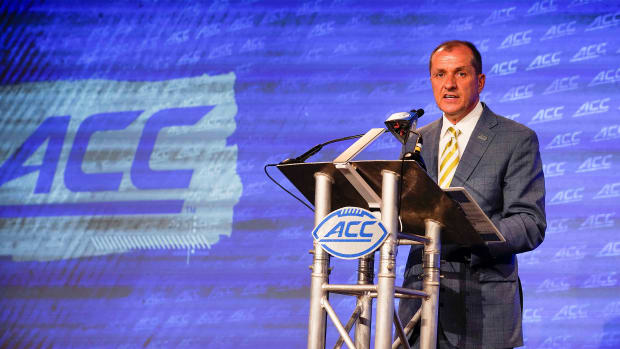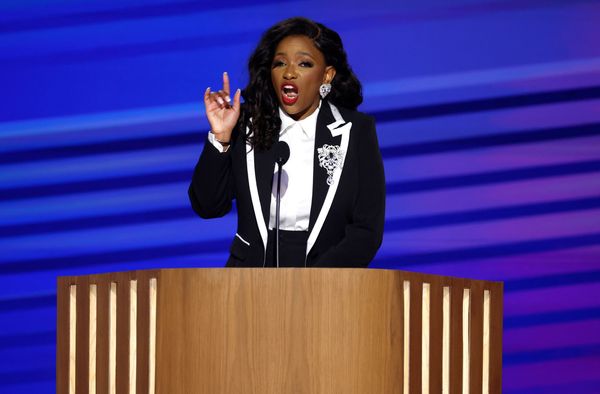CHARLOTTE — Jim Phillips is holding on to the string, gripping it as tightly as ever as the balloon drifts toward the heavens.
The college athletics model we have all known and loved for years is changing. It’s dying or, some might say, it is dead. It is floating like that balloon, off and away, never to be seen again.
“If we take the path that it’s only going to be about football and basketball, shame on us,” Phillips, the ACC commissioner, said before hundreds of reporters at his league’s media days Wednesday.
Among those within the industry, Phillips isn’t alone in refusing to let go of the balloon. Some might say that is quite valiant; others might say that is quite ignorant.

Jim Dedmon/USA TODAY Sports
This is about more than just new rules governing athlete compensation. This is about the structure and mission of college athletics, an industry that, because of megamillions in television revenue, finds itself stuck in a purgatory between amateurism and professionalism of which there is no path back.
Soaring television dollars have not only rightfully opened the door for college athlete compensation but are now also splintering the major conferences, dividing them financially in a way that is untenable. While conference membership shifts in a volcanic way—Texas and Oklahoma to the SEC; USC and UCLA to the Big Ten—more tectonic plates are stirring below the surface in the form of athlete employment. It’s a concept that, administrators say, threatens to debilitate the college Olympic sports model.
Suddenly, the tethering of higher education to major college football and men’s basketball seems flawed. Gone are traditions, history and the old ways. What many have predicted for years is beginning to materialize: the congregating of the biggest brands in college football chasing the biggest dollars and leaving behind their little brothers for some kind of semiprofessional entity.
Phillips describes college sports as a “neighborhood,” and for that neighborhood to be healthy, all of the homes must remain together. Yet, he acknowledges, the neighborhood is fracturing. Gated communities are forming.
As much as he’d like to be, his league isn’t behind the gates. Despite having the largest grouping of big brands in college football and basketball outside of the Big Ten and SEC (think Clemson, UNC, FSU and Miami), the ACC is not in the club.
In his 18th month atop the conference, Phillips’s members are squirming over the separation in revenue between them and their rivals. Projections show the Big Ten and SEC, in their new television deals, as much as doubling the revenue generated by the ACC, whose members are locked into an ESPN media rights contract that stretches 14 more years. The Power 5 and Group of 5 are now described by one administrator as “the Big 2, Other 1 and Group of 7.”
The ACC is the Other 1, in arguably the third-best position but with a chasm separating it from the other two. “We understand where those two leagues are. We are trying to find ways to close that gap,” Phillips said.
But how? All options are on the table, he says. Though he didn’t detail those, they are quite obvious: (1) add membership; (2) partner with another league; or (3) adjust the league’s revenue distribution model.
Let’s take No. 1. The only team that makes real sense and adds value to the ACC is Notre Dame, and the Irish, despite ACC overtures, seem content to remain independent in football.
But if the Irish do decide to join a league, Phillips says he “feels really good” about them joining the ACC and not the other obvious landing spot: the Big Ten. When asked why later, he referenced the agreement Notre Dame made with the ACC when it joined in all other sports. The Irish have their own nine-figure exit fee if they were to also leave the league for another conference as well as ceding their rights in the other sports.
No. 2 remains a possibility. A partnership between the ACC and Pac-12 remains alive, sources indicate to Sports Illustrated. But will such a deal really add that much more value to the leagues? That’s not known yet as officials explore the data. ESPN has invested millions into the ACC. Isn’t it for the good of the network to keep the league relevant?
“They want to help the ACC. They need to help the ACC,” Phillips said.
No. 3 means ending the longtime practice of distributing revenue evenly across the conference. Instead, the league would split dollars unevenly, based potentially on performance and other factors. Sure, it’s “on the table,” Phillips says, but is it really a solid solution—to decrease dollars to the weak and further enrich the strong?
Maybe there’s a fourth option that disrupts the entire conference. Maybe some of his members won’t wait around for any of this. Maybe they’ll challenge the Grant of Rights, the agreement that coincides with the TV contract and binds the schools together through 2036. The Grant of Rights gives the league control over the TV rights for all member schools’ home events. Not only would a school have to pay an automatic $120 million exit fee, but it’d have to negotiate what could be hundreds of millions of dollars in remaining media rights fees for every year it leaves early.
Are there ways out of the Grant of Rights? Phillips points to Oklahoma and Texas, who are fulfilling their own Grant of Rights through 2024 before leaving for the SEC. “I think it holds,” Phillips answered when asked before adding this: “But your guess is as good as mine.”
While he attempts to solve this festering revenue gap, Phillips continues to fight for the preservation of the collegiate model. For instance, he wants to leave championship events unchanged, such as the NCAA basketball tournaments, when others suggest cutting out the little guys. He eschews any talk of pay-for-play as it would adversely impact Olympic sports.
He’s clinging to the balloon, right or wrong, fighting what one administrator calls “the good fight.”
“We are not the professional ranks,” Phillips said from the podium Wednesday. “This is not the NFL. This is not NBA lite. This should not be a winner-take-all or zero-sum structure.”
Others would argue that it very much is.







